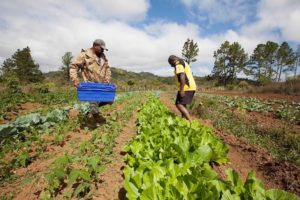Tanzania fights malnutrition by investing in food production
Given the importance of nutrition in the overall physical and cognitive development of children, there is a need to focus on the first 1,000 days of a child’s life to prevent the negative effects of malnutrition from becoming irreversible. This requires a multi-sector approach to…
 Given the importance of nutrition in the overall physical and cognitive development of children, there is a need to focus on the first 1,000 days of a child’s life to prevent the negative effects of malnutrition from becoming irreversible. This requires a multi-sector approach to address risk factors ranging from inadequate food and illness to poor access to safe drinking water, sanitation and hygiene. High rates of anaemia and low body mass index among adolescent girls and pregnant women are also causes of concern.
Given the importance of nutrition in the overall physical and cognitive development of children, there is a need to focus on the first 1,000 days of a child’s life to prevent the negative effects of malnutrition from becoming irreversible. This requires a multi-sector approach to address risk factors ranging from inadequate food and illness to poor access to safe drinking water, sanitation and hygiene. High rates of anaemia and low body mass index among adolescent girls and pregnant women are also causes of concern.
Improving children’s well-being at the earliest age must be an integral and systematic component of education and poverty reduction. It is essential to support the first phase of learning which begins with parents. Concerted efforts are needed to ensure that unnecessary deaths resulting from malnutrition especially in children under five years are brought to an end. Investing in nutrition is essential for Tanzania to progress.
In 2015, more than 2.7 million Tanzanian children under 5 years of age were estimated to be stunted and more than 600,000 were suffering from acute malnutrition, of which 100,000 were severe cases. It is estimated that the country will lose US$20 billion by 2025 if the nutrition situation does not improve. In contrast, by investing in nutrition and improving the population’s nutritional status, the country could gain up to USS 4.7 billion by 2025. Under nutrition is wrecking children’s lives. Globally, 161 million chronically undernourished children are not getting the right nutrients and care at the right time.
Under nutrition is the underlying cause of 43 per cent of child deaths. Average spending on nutrition at local government level has increased from TZS 65 million to TZS 125 million between fiscal years 2011/12 and 2015/16. Every year, that’s around 3.1 million deaths of children under the age of five. In the worst-affected countries, four in ten children are stunted. Their bodies and brains have not grown or developed properly. This long-neglected problem does not stop there. Undernourished girls grow into undernourished mothers who give birth to undernourished children.
Yara International, an organization fighting famine globally, helped create the Southern Agricultural Corridor of Tanzania (SAGCOT), an ambitious government-led public-private initiative aiming to revitalize 300,000 square kilometers of arable land. The initiative is expected to boost the incomes of thousands of farmers. Over the last decade, the Tanzanian government has encouraged investment in commercial rice, sugar and maize farming and processing facilities. “This created ready markets for produce, as government targets, supports and links rice farmers to the market,” says James Craske, Yara’s country manager.
Already the anticipated increase in productivity has triggered a demand for more fertilizers. To meet such demand, Yara set up a USD 26 million fertilizer terminal in the capital, Dar es Salaam, even as the organization and Tanzania’s government are working with local banks to provide financing for farmers. The Tanzanian model addresses food insecurity, youth unemployment and socio-economic exclusions. It can potentially spur rural development. However, the model has been criticized for destroying state-owned mangroves that provided food security for many citizens.
Related information
• Towards a food-secure Africa
• Kagera fights malnutrition by investing in food production
• Tanzania country profile (2017): English | Français | Español